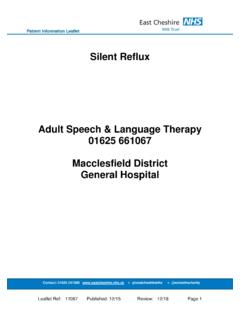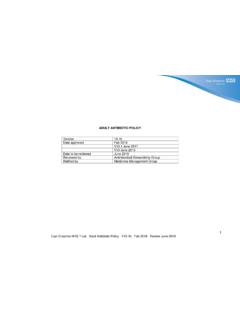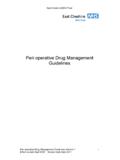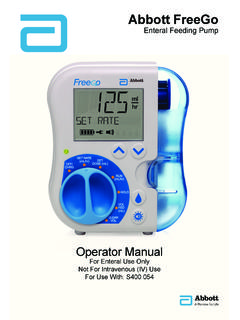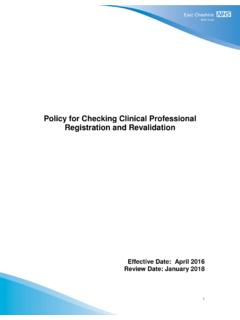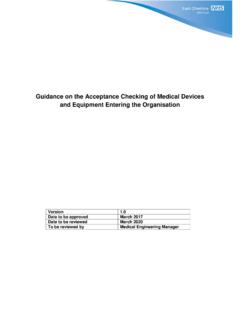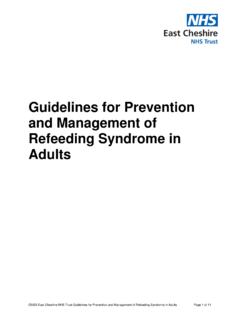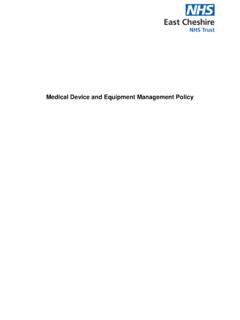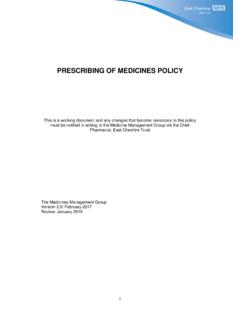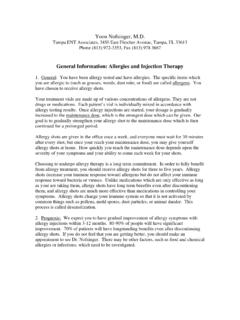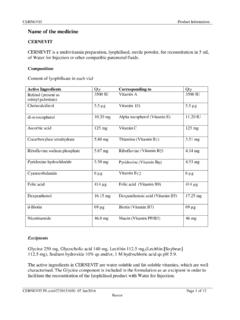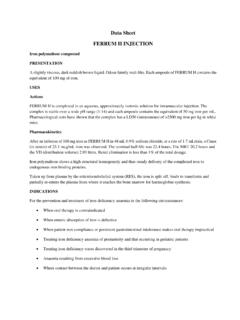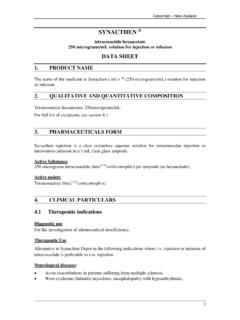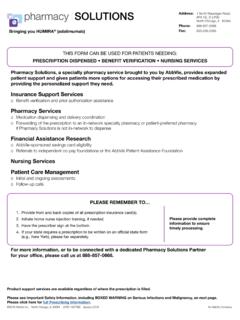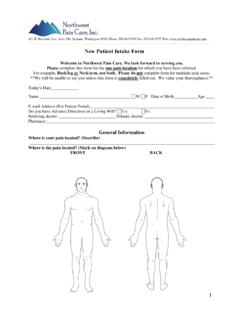Transcription of Standard Operational Procedure for …
1 Standard Operational Procedure for administration of intravenous iodinated contrast medium by Radiographers Title of SOP: Standard Operational Procedure for administration of intravenous iodinated contrast medium by Radiographers Dates: April 2012 Issue Date: Purpose and Background (ie Policy Statement and Background): Background Injection of intravenous (IV) Iodinated contrast medium is used routinely in CT scanning for opacification of vascular structures and organs, allowing improved visualisation of anatomy and some pathologies. Injection is via a cannula (inserted as per department SOP) and may be A hand injection ( usually a bolus of 50ml) Via the pressure injector (usually 100-150ml) Though adverse reactions are generally mild and self limiting more severe life threatening reactions can occur.
2 The individual administering the pharmaceutical must be aware of risk factors in order to minimize adverse reactions and should they occur, know how to promptly recognise and manage them. Side Effects Reactions are infrequent and may be mechanical or physiological. Mechanical: Extravasation of contrast may occur with either method of delivery of IV contrast but may have more serious sequela when the pressure injector is used, due to the pressure, volume of contrast and remote operation of the system. Air Embolism is a rare complication. Physiological Anaphylactoid more common in patients with history of previous contrast reaction and asthma, though anxiety and fear have an effect. Anaphylactoid reactions usually occur within 20 minutes of the injection but may occur with a delay of some hours and are independent of the dose administered.
3 Symptoms classified in three groups: Mild skin rash, itching, nasal discharge, nausea, vomiting Moderate persistence of mild symptom, facial or laryngeal oedema, bronchospasm, dyspnoea, tachycardia or bradycardia. Severe Life threatening arrhythmias, hypotension, overt bronchospasm, laryngeal pulmonary oedema, seizure, syncope, death. Nonanaphylctoid Reactions Result from the ability of the contrast media to upset homeostasis of the body. Larger volumes and route of administration affect the risk. Symptoms: Warmth, metallic taste, nausea, vomiting, bradycardia, hypotension, vasovagal reactions, neuropathy and delayed reactions. Contrast induced nephropathy (CIN) Acute renal failure which occurs within 48 hours of administration of iodinated contrast, which is not attributable to other causes. Risk is increased in patients with with pre-existing renal dysfunction and those with concurrent conditions and medications which may affect renal function.
4 To minimise side effects and optimise patient care Radiographers administering intravenous contrast must adhere to the following Standard Operational Procedure . Scope ( organisational responsibility) Vital functions affected by this SOP: This document applies to all Radiographers when administering IV iodinated contrast during CT examinations. Escalations (if you require any further clarification re the process outlined please contact): CT Lead Radiographer Senior Radiographer of the day Clinical Lead in Radiology Author: Angela Smith CT Lead Radiographer Section 2: Operating Procedure 1. The radiographer must have completed a recognised IV cannulation course and completed the departmental record of practical training. (Appendix 2) 2. The radiographer must be up to date with the Trust mandatory training in resuscitation.
5 3. A Patient Group Directive (PGD) for each contrast agent/drug to be injected must be signed by the Radiographer following appropriate training. Optiray 300 mg iodine/ml (active ingredient ioversol) Visipaque 270mg/ml (active ingredient iodixanol) Niopam 300mg/ml ( active ingredient iopamidol) 4. The Radiographer must complete the departmental training for the use of the power injector 5. Between the hours of 9am 5pm Monday to Friday a Radiologist must be in the department when delegation of this duty occurs, to provide advice and cover in the event of an adverse reaction. 6. Between the hours of 5pm and 9am Monday to Friday, and 5pm on Friday until 9am on Monday all inpatients referred for a contrast CT must be accompanied by a member of staff from the referring ward/team. In the event of a suspected evolving adverse reaction medical staff from A/E department will provide support.
6 Advice on the appropriateness of IV contrast in high risk patients must be sought from the on-call Radiologist. 7. Radiographers must only administer injections to adults (16 years and above). 8. The pharmaceutical and its dose should be given by the radiographer in accordance with established departmental protocols, or as individually advised by the supervising Radiologist. 9. The Safety Questionnaire for Outpatients Undergoing CT Scanning or the Checklist for inpatient CT scans must be completed: (Appendix 1) 10. To minimise the risk of CIN all patients must be well hydrated prior to administration of iodinated contrast. Out patients all out patients attending for Iodinated contrast CT examinations will be advised to drink 500ml water over the hour proceeding their CT appointment. Information is also given to hydrate ( 1 litre of water over 24 hours) after the scan.
7 On arrival at the department a further 500ml water is given to support hydration. On completion of the scan the Radiographer must reiterate the post scan hydration advice. Drink 1 litre of water over the next 4-6 hours. Inpatients if eGFR is between 30-60 inpatients must be hydrated prior to CT. The clinicians must assess individually and ensure that hydration is optimised. The following regime is a recommendation only. IV hydration Normal saline at 100ml/hour for 4 hours prior to the CT study and for 12 hours after the study at the same rate. Oral hydration 500ml of fluid 2-4 hours prior to the CT study and over the 24 hours following. 11. If the patient reports a history of severe allergic reaction to any substance, the supervising Radiologist must be consulted before proceeding.
8 12. If the patient has poorly controlled asthma, which has required recent hospitalisation consult the supervising Radiologist before proceeding. 13. If the patient is known to suffer from any of the conditions stated on the Safety Questionnaire consult the supervising Radiologist before proceeding. 14. Check renal function on all inpatients and outpatients known to have a renal problem. 15. Renal Function parameters and iodinated contrast: eGFR greater than 60 proceed with iodinated contrast eGFR between 30-60 implement hydration policy ( see 13 above) eGFR below 30 discuss with Radiologist before proceeding 16. Emergency Drugs must always be available in the room 17. A second member of staff must be available to assist whilst an injection is taking place: To observe the injection site for extravasations To assist if an emergency situation arises 18.
9 If extravasation occurs: Abort the injection immediately Assess the pulse distal to the injection site Manage small extravasations by removing the cannula, elevating the limb and applying a cold compress. Larger volumes (50ml +) inform the supervising Radiologist. 19. If a patient has an adverse reaction, however mild, one member of staff must stay with the patient whilst the second informs the supervising Radiologist. 20. Any adverse reaction must be documented on CRIS and for inpatients, in the notes. 21. Type/quantity and batch number of all injection must be checked by two members of staff 22. Following injection with iodinated contrast the patient must not be left unsupervised for 5 minutes and must remain in the department for at least 20 minutes. The patient must be advised to stay within the hospital for 1 hour following the injection and not to drive for 1 hour following the injection.
10 23. Patients who are deemed to be higher risk should remain in the department for at least 30 minutes post injection. 24. Saline may be injected by the Radiographer to check and maintain patency of the cannula 25. ALL DOCUMENTATION MUST BE COMPLETED ON THE APPROVED FORM AND SCANNED INTO THE PATIENTS FILE ON CRIS Appendix 1 Safety Questionnaire for Patients Undergoing CT Scanning Your doctor has asked us to perform a CT Scan. This involves the use of x-rays and an intravenous injection of contrast (dye). It is important that you complete the following information prior to your scan. Please hand the completed form to the CT Radiographer at the time of your appointment. Checklist Do you suffer from any of the following: Yes No Comment Have you had x-ray contrast before?
